In the grand game of plant identification, where every leaf and flower is a clue, Mullein can be a tricky character. It boasts a striking appearance, like a towering Gandalf with a staff of yellow flowers and a velvety cloak of leaves. But beware, adventurers! Mullein has doppelgangers, Mullein Look Alikes, lurking in the wild, waiting to confuse even the most seasoned herbalist.
These imposters can look deceptively similar, leading you to believe you’ve stumbled upon nature’s multi-tool. But before you brew a cup of “Mullein” tea, make sure you’ve identified the real deal. Unlike Gandalf, these look-alikes may not possess the same magical herbal properties.
The key to conquering this botanical challenge lies in understanding Mullein’s true form. We’ll delve into its unique characteristics and equip you with the knowledge to differentiate it from its mischievous twins. So, grab your magnifying glass and sharpen your detective skills – it’s time to separate the Mullein from the mundane!
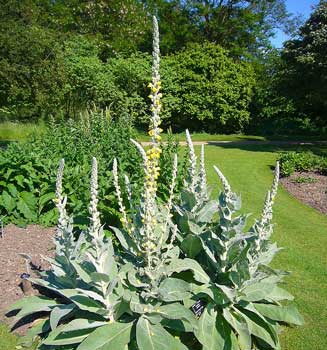
Mullein
Identifying Mullein
Mullein, a towering figure in the herbal world, commands attention with its majestic presence. Its statuesque stem, reaching up to 8 feet high, culminates in a spike of vibrant yellow flowers, resembling a regal staff. But Mullein’s beauty extends beyond aesthetics. Its soft, velvety leaves, reminiscent of nature’s luxurious bath tissue (though with a far nobler purpose!), offer a hint at the soothing properties within.
The Versatility of Mullein
This botanical powerhouse boasts a rich history in herbal remedies. Celebrated for its anti-inflammatory, antiviral, and antibacterial properties, Mullein thrives in tackling respiratory woes. Imagine a warm hug for your lungs – that’s Mullein tea, brewed from its leaves and flowers. This comforting concoction soothes sore throats, eases coughs, and combats infections. Mullein’s power extends beyond the respiratory system, offering relief for skin irritations and mild infections thanks to its gentle, healing nature.
Mullein Look-Alikes
Mullein is a beneficial herb with a long history of medicinal use. However, it’s important to be able to identify mullein correctly, as there are several plants that resemble it. Here’s a closer look at some common mullein look-alikes:
1- Lamb’s Ear (Stachys byzantina)
- Appearance: Lamb’s ear is notable for its soft, velvety, silver-green leaves that are shaped somewhat like a lamb’s ears, hence the name. It rarely flowers, but when it does, the flowers are small and purplish.
- Habitat:This plant thrives in well-drained soil and full sun to partial shade. It’s native to Turkey, Armenia, and Iran.
- Benefits:Lamb’s Ear has been used traditionally for its antibacterial properties, often applied to wounds.
- Toxicity:It’s generally considered non-toxic to humans and pets.
- Similarity with Mullein:The soft, woolly leaves are reminiscent of young mullein leaves, though Lamb’s Ear does not grow a tall flower spike.
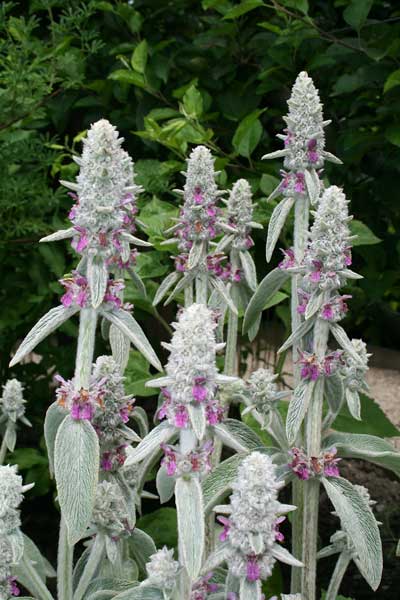
2- Foxglove (Digitalis purpurea)
- Appearance:Foxglove features tall spikes of tubular flowers in shades of pink, purple, white, and yellow. The leaves are green, large, and downy.
- Habitat:Prefers acidic soils, partial shade, and is native to Europe.
- Benefits:Contains digitoxin, used in drugs to treat heart conditions (Important Note: Foxglove should not be used as a herbal remedy without consulting a medical professional).
- Toxicity:Highly toxic if ingested, can cause heart failure and death.
- Similarity with Mullein:The tall flower spike resembles mullein’s, though the flowers and plant toxicity vastly differ.
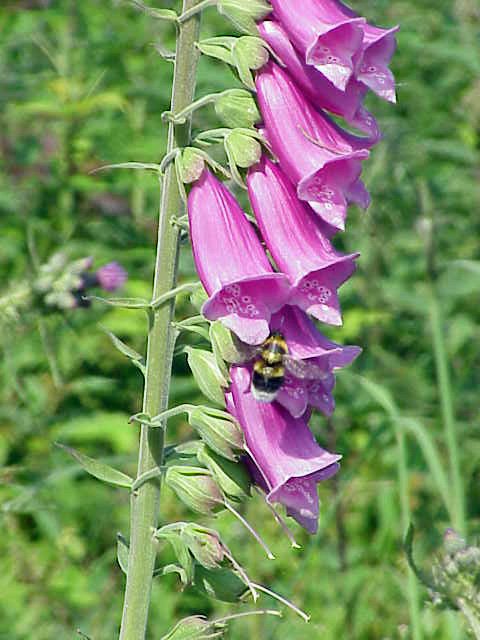
3- Hollyhock (Alcea rosea)
- Appearance:Hollyhock plants have tall, erect spikes covered with large, colorful flowers ranging from white to dark red. The leaves are large and rough-textured.
- Habitat:Thrives in well-drained soil, full sun, and is native to China and the Mediterranean region.
- Benefits:Used traditionally for its anti-inflammatory and diuretic properties.
- Toxicity:Generally considered safe, though it can cause skin irritation in some people.
- Similarity with Mullein:Shares a tall, erect growth habit with mullein, though the flowers are much larger and more colorful.
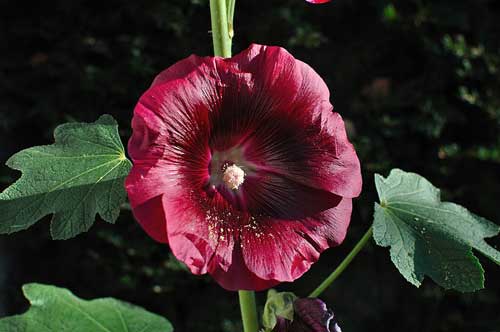
4- Borage (Borago officinalis)
- Appearance:Borage has star-shaped blue flowers and hairy, cucumber-flavored leaves.
- Habitat:It grows well in most soils and climates, preferring full sun.
- Benefits:Known for its anti-inflammatory and calming properties. The leaves and flowers are edible.
- Toxicity:Generally safe, but contains small amounts of pyrrolizidine alkaloids which can be toxic in large quantities.
- Similarity with Mullein:The hairy leaves may remind one of mullein, though borage is shorter and the flowers are blue.

5- Comfrey (Symphytum officinale)
- Appearance:Comfrey has large, hairy leaves and bell-shaped flowers, typically purple, pink, or white.
- Habitat:Grows in damp, grassy places, and is native to Europe.
- Benefits:Used for skin and bone healing due to its allantoin content. (Important Note: Comfrey should not be used internally or on open wounds due to its liver toxicity).
- Toxicity:Contains pyrrolizidine alkaloids, which are toxic to the liver if ingested in large amounts.
- Similarity with Mullein:The large, hairy leaves are somewhat similar, but comfrey’s flowers and toxicity set it apart.

6- Elecampane (Inula helenium)
- Appearance:Elecampane has large, broad leaves and tall stems topped with yellow, daisy-like flowers.
- Habitat:Prefers sun or partial shade and rich, moist soil. Native to Europe and Asia.
- Benefits:Known for its expectorant properties, used to treat respiratory issues.
- Toxicity:Generally safe in small doses; large amounts can cause digestive upset.
- Similarity with Mullein:The tall stem and yellow flowers can be reminiscent of mullein, though elecampane flowers are daisy-like and its leaves are broader.

7- Black Cohosh (Actaea racemosa)
- Appearance:Black Cohosh features tall spikes of small, white, feathery flowers above a clump of large, compound leaves.
- Habitat:Prefers shady locations with moist soil and is native to eastern North America.
- Benefits:Commonly used to treat menopause symptoms and menstrual cramps.
- Toxicity:Can cause gastrointestinal distress, and in large doses, liver damage.
- Similarity with Mullein:The tall, flowering spikes might look similar from a distance, but black cohosh’s flowers and leaf structure are quite different.
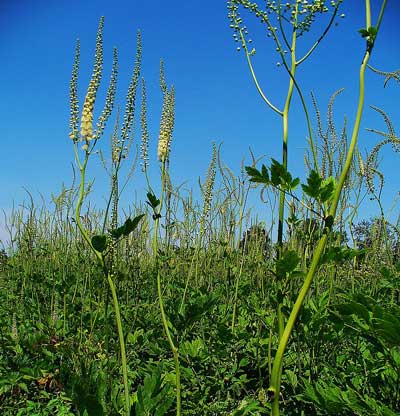
8. Chicory (Cichorium intybus)
Appearance: Chicory (Cichorium intybus) features slender, elongated leaves forming a basal rosette close to the ground. Its leaves often have serrated edges, and the plant produces tall stems topped with clusters of bright blue, daisy-like flowers.
Habitat: Chicory thrives in sunny, open habitats such as roadsides, meadows, fields, and disturbed areas. It prefers well-drained soils but can tolerate various soil types.
Benefits:
- Medicinal Properties: Chicory root is known for its potential health benefits, including aiding digestion, liver health, and serving as a diuretic. It may also possess anti-inflammatory and antioxidant properties.
- Soil Improvement: Chicory’s deep taproots help break up compacted soil and improve soil structure. It also facilitates nutrient uptake from deeper soil layers.
Toxicity: While generally safe, excessive consumption of chicory leaves or roots may cause digestive discomfort in some individuals. Allergic reactions are also possible.
Similarity with Mullein: Chicory and mullein (Verbascum thapsus) share habitats like roadsides and fields but can be differentiated by leaf shape, flower color, and growth habit. Chicory’s slender leaves and bright blue flowers contrast with mullein’s broad, fuzzy leaves and clusters of small, yellow flowers.
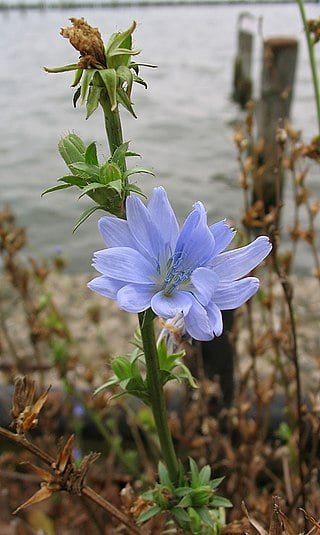
Remember: When foraging for or using any herbal remedy, accurate identification is crucial. Mullein look-alikes may resemble the plant but lack its benefits or, even worse, be harmful. It’s always best to consult a qualified herbalist or healthcare professional before using any plant for medicinal purposes.
Mullein Look Alikes Conclusion
Mullein, a towering medicinal plant with velvety leaves and yellow flowers, stands out in the plant kingdom. But beware! Mullein Look alikes like Lamb’s Ear and Foxglove lack Mullein’s healing properties and can even be toxic. Learning to tell them apart is vital. Mullein tea, made from its leaves and flowers, is a safe and effective remedy for coughs, respiratory issues, and even skin irritations. So, embrace the true “towering healer” while staying mindful of its deceptive twins.
FAQ: Mullein and Its Botanical Counterparts
What are some plants that look like mullein?
Woolly mullein (Verbascum thapsus) is a common plant that closely resembles mullein. Additionally, lamb’s ear (Stachys byzantina) shares some visual similarities with mullein.
How can I tell the difference between lambs ear and mullein?
While both lamb’s ear and mullein have fuzzy leaves, lamb’s ear leaves are smaller and densely covered in a velvety texture, resembling the ears of a lamb. Mullein leaves are broader and elongated, with a softer texture and a distinct shape.
How to identify chicory ?
Chicory (Cichorium intybus) has slender, elongated leaves forming a basal rosette close to the ground. It produces tall stems with clusters of bright blue, daisy-like flowers.
Is mullein invasive?
Mullein (Verbascum thapsus) is not considered invasive in most regions. However, it can colonize disturbed areas such as open banks and vacant lots.
Can you smoke lambs ear plant?
While lamb’s ear (Stachys byzantina) does not possess any known psychoactive properties, some people may choose to smoke it for relaxation or ceremonial purposes. However, caution should be exercised as smoking any plant material can pose health risks.
What are lambs ear benefits ?
Lamb’s ear has antimicrobial properties and is often used as a topical antiseptic or natural bandage due to its velvety leaves. It may also have ornamental value in gardens.
What are the benefits of mullein?
Mullein is valued for its medicinal properties, including being an expectorant, anti-inflammatory, and antiviral agent. It is commonly used in herbal teas and remedies for respiratory issues.
How to identify mullein?
Mullein can be identified by its tall, erect stem with clusters of yellow flowers, broad and fuzzy leaves, and its preference for open, sunny habitats such as fields and roadsides.
What are common mullein look alikes ?
Woolly mullein and lamb’s ear are two plants that are often mistaken for mullein due to their similar appearance, especially their fuzzy leaves.
What are some common mullein plant look alikes?
Common mullein (Verbascum thapsus) may be mistaken for moth mullein (Verbascum blattaria) or velvet plant (Verbascum densiflorum) due to similarities in their foliage and flower structures.
How do I differentiate between mullein and chicory?
Mullein and chicory can be distinguished by their leaves, with mullein having broad, elongated leaves, while chicory has slender, serrated leaves. Additionally, mullein produces yellow flowers on tall stems, whereas chicory has bright blue flowers on slender stems.
Where does chicory grow?
Chicory (Cichorium intybus) is often found growing in sunny, open areas such as roadsides, meadows, and disturbed soils. It is native to Europe but has naturalized in many other regions worldwide.
What is the “cowboy toilet paper plant”?
The term “cowboy toilet paper plant” is sometimes used colloquially to refer to lamb’s ear (Stachys byzantina) due to its soft, velvety leaves, which can be used as an alternative to toilet paper in outdoor settings.
What are the Stachys byzantina benefits ?
Lamb’s ear has various benefits, including its antimicrobial properties, which make it suitable for use as a topical antiseptic or natural bandage. It is also drought-tolerant and adds ornamental value to gardens with its soft, fuzzy foliage.
Is mullein lambs ear?
No, mullein (Verbascum thapsus) and lamb’s ear (Stachys byzantina) are two distinct plant species. While they may share some visual similarities, such as fuzzy leaves, they have different characteristics, habitats, and medicinal uses.
How can I tell the difference between cornflower vs chicory?
Cornflower (Centaurea cyanus) and chicory (Cichorium intybus) can be differentiated by their flowers. Cornflower has bright blue, disc-shaped flowers, while chicory has similar blue flowers but with ray and disc florets arranged in a daisy-like pattern.
Waht are chicory look-alikes?
Chicory may be confused with plants like dandelion (Taraxacum officinale) due to similarities in flower color and shape. However, dandelion leaves lack the elongated, serrated appearance of chicory leaves.
What are some common mullein plant look-alikes?
Some plants that resemble mullein include moth mullein (Verbascum blattaria), velvet plant (Verbascum densiflorum), and woolly mullein. These plants share similarities in leaf shape and flower structure, but careful observation can help differentiate them from true mullein.
Is chicory invasive ?
Yes, chicory (Cichorium intybus) can be considered invasive in certain regions. While native to Europe, chicory has naturalized in many parts of the world, including North America, where it can spread rapidly in disturbed habitats such as roadsides, meadows, and fields.
What is difference between mullein and lambs ear ?
The difference between mullein (Verbascum thapsus) and lamb’s ear (Stachys byzantina) lies primarily in their physical characteristics, habitat preferences, and uses:
Physical Characteristics:
What does mullein look like: Mullein plants are tall and erect, reaching heights of several feet. Their leaves are broad, elongated, and covered in a soft, fuzzy texture. Mullein produces clusters of small, yellow flowers on a single, tall flowering stem.
Lamb’s Ear: Lamb’s ear plants are low-growing and form dense clumps. Their leaves are small, densely packed, and covered in a velvety texture, resembling the ears of a lamb. Lamb’s ear produces shorter flowering spikes with small, inconspicuous flowers.
Habitat Preferences:
Mullein: Mullein prefers open, sunny habitats such as fields, meadows, roadsides, and disturbed areas like vacant lots.
Lamb’s Ear: Lamb’s ear thrives in well-drained, sunny locations but can also tolerate some shade. It is commonly found in gardens, along paths, and in dry landscapes.
Uses:
Mullein: Mullein has various medicinal uses, including as an expectorant, anti-inflammatory, and antiviral agent. It is commonly used in herbal teas and remedies for respiratory issues.
Lamb’s Ear: Lamb’s ear is primarily valued for its ornamental qualities in gardens due to its soft, velvety foliage. It also has some medicinal uses, particularly for its antimicrobial properties, and can be used as a natural bandage or topical antiseptic.
Conclusion
In conclusion, while mullein and its look-alikes, share some visual similarities, they each possess distinct characteristics and benefits. Mullein stands tall as a versatile flowering plant with medicinal properties, including its role as an antioxidant and its use in herbal teas and remedies, particularly during the cold season. Woolly mullein, with its dense, velvety foliage, adds to the diversity of native grasses and roadside plants, offering potential antibacterial properties and herbal remedies. Lamb’s ear, with its soft, fuzzy leaves, serves as a natural antiseptic and herbal supplement, providing relief for various ailments. Chicory, often mistaken for mullein, contributes its own unique qualities, such as its blue daisy-like flowers and chicory root, which is valued for its herbal cleanse and medicinal herb properties. Understanding the distinctions between these plants is essential for harnessing their respective benefits and appreciating their roles within botanical families.
For further exploration of gardening articles, kindly visit our webpage: Home Garden
There’s a particularly good way. Before you go looking for it in the wild, you can batch custom-made stickers with mullein patterns and imposters stickers.
Often take out such Custom Sticker to look at and distinguish them. Not only can you distinguish plants, but they can also become beautiful decorations, killing two birds with one stone.

